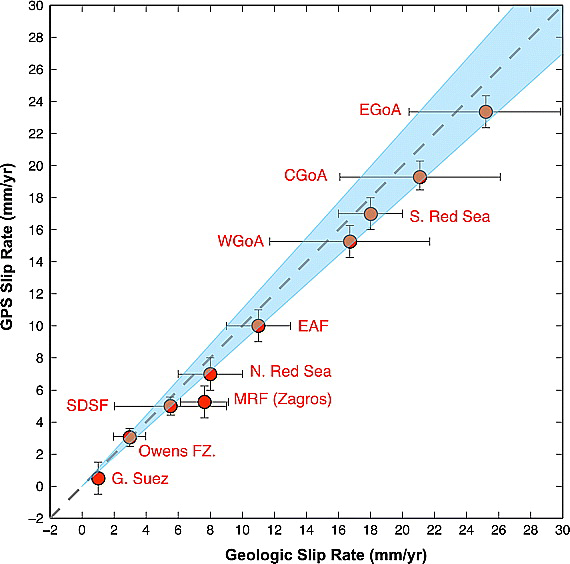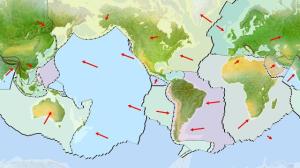One frequently-peddled YEC lie is the assertion that there are two classes of science, 'historical science' and 'observational science', with the latter being trumpeted as the only true science. As I have posted elsewhere, this is a bogus distinction which is not recognised by mainstream scientists, but rather is a desperate YEC attempt to disparage geology which confirms the reality of an ancient Earth. Anyone who refers to 'historical science' and 'observational science' as if these distinctions actually existed is betraying both an uncritical acceptance of YEC propaganda, and a superficial grasp of scientific epistemology.
However, even if one accepts this bogus distinction for the sake of argument, a 2010 paper examining crustal plate motion in south west Asia shows that geological slip rates determine from radiometric dating agree quite well with those directly measured by GPS methods, meaning that the results obtained from 'historical science' agree with those from 'observational science'. In other words, there is no 'historical science' or 'observational science'. There is just science, and what it does show is the utter falsity of the belief in a young Earth.
At Naturalis Historia, Joel Duff comments on how this paper comprehensively undermines the YEC belief in a young earth:
This graph shows the smoking gun.
Smoking gun evidence of what? That the earth’s plates have been moving slowly for millions of years.
Therefore the Earth is very, very old.
Radiometric/Geological estimates vs Geodetic/GPS estimates of continental plate motions. Figure from AlReheji et al. 2010.
This graph should cause creationists to lose sleep at night, wondering why God provided such contrary data to a young earth. Some will grasp for an escape chute and claim that these data are the result of God’s creating with the appearance of age while others will cast doubts on the data themselves but at the end of the day, both of these claims are without theological or scientific merit.
This graph shows that the so-called historical sciences and observational sciences that Ken Ham touts can both reach the same conclusions.
The graph includes data that are far from novel. The data don’t reveal anything that hasn’t been common knowledge among geologists for a long time. But this graph won’t make an appearance in your recent issue of Creation Magazine or be highlighted on the Answers in Genesis website.
Basic diagram of the crustal plates of the Earth and their general direction of motion. Plates are moving at different speeds with some moving away from each other and other running into each other. How the plates interact explains much about the origins of earthquakes and volcanoes.
So what is this a graph of?
It compares two different estimates of how quickly the earth’s plates are moving in the Middle East. The first method of measurement (X axis) employs radiometric dating of rocks (that are millions of years old) to calculate the average rate of plate motion over that time. The second method measures the rate of plate motion based on GPS readings of the precise locations of the plates (Y axis). These GPS measurements were recorded over a 10 year period. This allowed the rates of plate motions to be directly measured as well as an average estimated over that time period.
Plates that move a few millimeters in a few years? Yes, initially this may seem a rather dull finding. But these data are remarkable for one reason: In almost all cases the estimates derived from these independent methods are in full agreement!
Why is this agreement significant and how does it prove that the world is ancient?
It is significant because it shows how predictions in science can provide powerful confirmation of a theory, when those predictions are confirmed by future observations. The geological slip rates were determined by several methods, involving multiple research teams over the past 50 years. I could spend 5000 words describing exactly how these rates were calculated, but it makes no difference how this was done or that your understand the methods. All that matters is that estimates of rates have been produced by multiple labs over decades. These rates were calculated using conventional – old earth – assumptions about radiometric dating. This includes producing dates for for 1 to 20 million years were obtained and used to back-calculate rates in millimeters per year movement. These studies produced rates of plate motion that represent the speed of plates over millions of years in the past but were predicted to represent the present day motion of the plates.
When these millions of years rates were calculated, there were no instruments precise enough to measure the present-day motion of the plates. But now we have lasers and global positioning satellites that can track precise movements of the earth’s crust down to hundredths of millimeters per day. This allowed geologists to directly test the rates predicted by radiometric dating of millions of year old rocks.
The key results: dates based on old rocks predict the same rates as GPS measurements of real-time plate motions.
What does this mean?
It means that current plate motions are the same, or nearly the same, as plate motions from 100, 10,000 or 1 million years ago. The probability that these rate numbers, based on two independent methods of estimation, happen to be the same as a result of chance alone is so small that it makes winning the PowerBall look like a sure bet. This is as confident as one can be that tectonic plates have been slowly moving for vast periods of time. This is smoking gun evidence that these processes have been occurring continually for millions of years.Radiometric dating is of course a reliable method of dating rocks, so it hardly needed this evidence to grant it credibility. The remarkable consonance between relative dating from stratigraphy and absolute dates from radiometric dating, and the fact that different dating methods when used on the same rock converge to the same value alone are enough to demonstrate this fact to the fair, honest, open-minded person. However, this line of evidence further emphasises the essential reliability of the method and as mentioned before, destroys the tired 'historical science' versus 'observational science' dichotomy created by the YECs simply to explain away some of the most powerful evidence against the myth of a young Earth.
The evidence is simply impossible to reconcile with a young earth. As Duff notes:
I risk being redundant, but this point is important to emphasize. These values should NOT be the same if the worlds tectonic plates are only 4500 years old as predicted by flood geology.
Why would radiometric dating, which supposedly is a useless tool for estimating the true age of the earth by YEC reckoning, provide near-precise estimates of current plate motions, which are confirmed by a completely unrelated form of measurement?
For the YEC hypothesis, they shouldn’t. And yet they do.
The only reasonable explanation for what we see here is that the radiometric dating methods provide faithful estimates of the real ages of the rocks. The GPS data are yet another independent confirmation of the validity of radiometric dating. The fact that radiometric based dates predicted rates that were confirmed later by another method serve to confirm the former method. (Emphasis in the original)We are in no doubt as the the fact of an ancient Earth. The evidence is beyond dispute, and resorting to the dishonesty of claiming that the universe was created to 'look old' is an argument of desperation that was rightly rejected by Christians in the 19th century when it was first floated as being morally repugnant for its claim that "God has written on the rocks one enormous and superfluous lie for all mankind".
Attempting to hand wave away this evidence by consigning it to the fiction of 'historical science' likewise is intellectually dishonest, but as shown fails because even if one adopts the dichotomy proposed by YECs, both 'branches' of science agree with each other, confirming by YEC 'epistemology' the reliability of radiometric dating as 'observational science' has verified 'historical science.'

